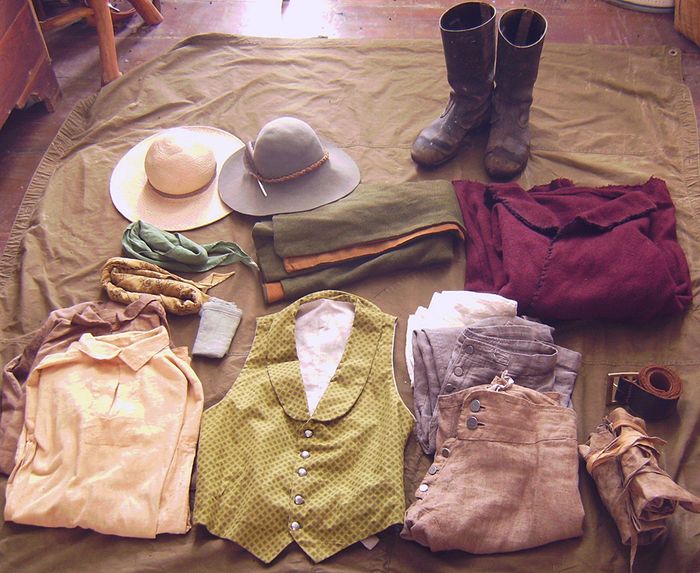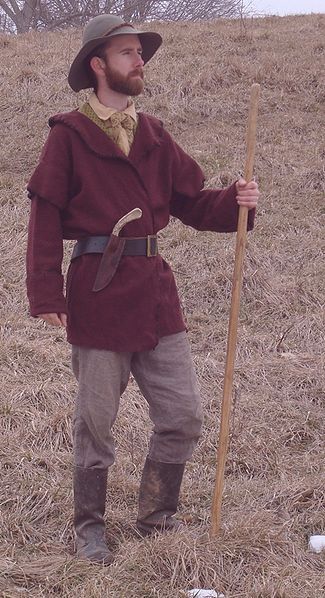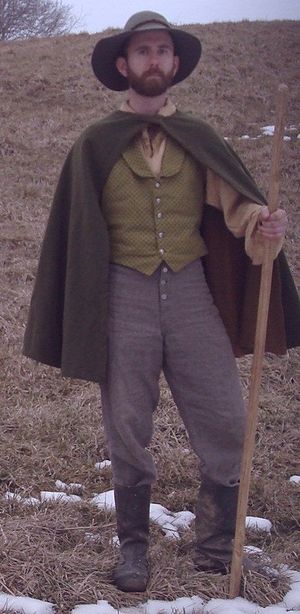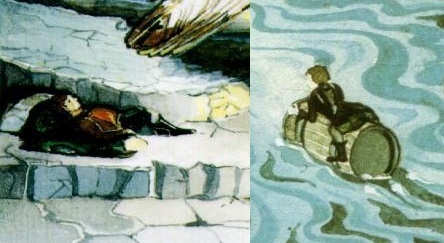Tungo: Soft Kit
Based on the material culture depicted in Tolkien's texts, I’ve chosen to draw hobbit clothing from our Primary World period of roughly 1750-1850; the usual barefootedness and adherence to strictly pre-gunpowder weapons differentiate this from what would otherwise be a standard impression of that period. While sewing machines do show up within this timeframe (depending on your source, in 1790, 1830, or 1845), they are nonetheless “more complicated than a forge-bellows, hand-loom, or water-mill” (FotR 1), and so—with the exception of a very few seams of my vest—I elected to do all my sewing by hand. As this is generally a warm weather impression, the vast majority of my soft kit is made of 100% linen, although several woolen items allow for excursions in colder weather.
Basic clothing
For underclothes, I wear linen boxer shorts. (cf. Sam’s “linen” (FotR 315). On my body I wear a linen drop-shouldered ‘trade shirt’ [1], which I dyed a beautiful golden colour with onionskins, as not only were hobbits familiar with onions (TTT 295), but were “notably fond of yellow and green” (FotR 2)! In addition to my yellow shirt I have another common ‘trade shirt’ which has been dyed with black walnuts. This provides an extra layer if needed, or perhaps better concealment while hunting or beating the Bounds.
Over my shirt I wear a vest/waistcoat/weskit (FotR 33; RotK 319), the body of which is a green cotton print – it is modern material unfortunately, but I had enough leftover from a quilting project and it screamed ‘hobbit!’ to me. It will eventually be replaced with a pocketed waistcoat in a more appropriate material—wool, probably—one of these years. This vest is a ‘shawl-collar’ style, of a pattern popular in the 1830s, and is lined with linen.
In warmer weather I wear a plain green linen neckerchief, but to keep my neck warm in chillier months, I tie a neckerchief I commissioned from Laura Sylvester [2]. It is made of raw silk (TH 301; FotR 33), dyed with osage and an iron mordant. It is decorated by hand with a brown, 18th century floral block print.
On my lower body in warm weather, I wear a pair of 1750s-pattern fly-front knee breeches (FotR 54, 163, 312; Letter 35, 280) made of heavy linen [3] dyed with black walnut stain. The pewter buttons came from Jas. Townsend’s [4] bucket of ‘seconds’ for a less mass-produced look. The pattern for these breeches came from Beth Gilgun’s book Tidings from the 18th Century (ISBN 1880655047), which is quite indispensable for living-history of the period. Although my breeches are very tough linen, while beating the Bounds I can also protect my legs from brambles and the like by wearing my buckskin leggings over my breeches.
In cold weather, I wear a simple pair of $2 thrift-store linen trousers (FotR 117), which I modified by removing the pockets, zipper, and adding a button fly and pewter buttons. If it is very cold I will add a pair of wool/cotton leggings under the trousers. I keep my upper body warm with either a long-sleeved wool jacket belted around me, or in more Middle-earth style, a short wool cloak.
Unlike what Peter Jackson’s interpretation would have us believe, Tolkien’s hobbits were very familiar with wearing hats (TH 1, 30; FotR 11, 78; RotK 288), and so on my head I wear a wide-brimmed straw (in summer) or felt (in cool months) hat, with a grey goose feather stuck in the band as symbol of membership among the Bounders (FotR 11).
Although hobbits are usually barefoot, there are two precedents for footwear among them. The first is the Eastfarthing habit of wearing “dwarf-boots in muddy weather” (FotR 7) and the second is Tolkien’s correspondence in which he laments his omission of Bilbo acquiring boots at Rivendell (Letters 35). Tolkien also drafted that hobbits disliked getting “mud and clay on their feet” (HoME Vol 6).
For additional visual proof, one need look no further than Tolkien’s own depictions of Bilbo on the Quest of Erebor in post-Rivendell episodes—specifically the pieces ‘Bilbo woke up with the early Sun in his eyes’ and ‘Bilbo comes to the huts of the raft-elves’.
In these illustrations we see our titular hobbit wearing high black boots. In accordance with these representations, I wear a pair of simple and sturdy (albeit modern) calf-high East German military boots.
BONUS
Here is my partner R. among the tents at the Free Fair, also dressed in common hobbit-lass fashion. Her underlayer is a cotton chemise, with a flannel petticoat for warmth. Over the chemise is a brown skirt, with a linen apron (with pockets) tied over that. A rustic ‘shortgown’ or jacket covers her upper body, with my neckerchief to keep her neck warm. Over everything she wears a lined wool cloak to cut the wind. The basket of razar came from my orchard!






